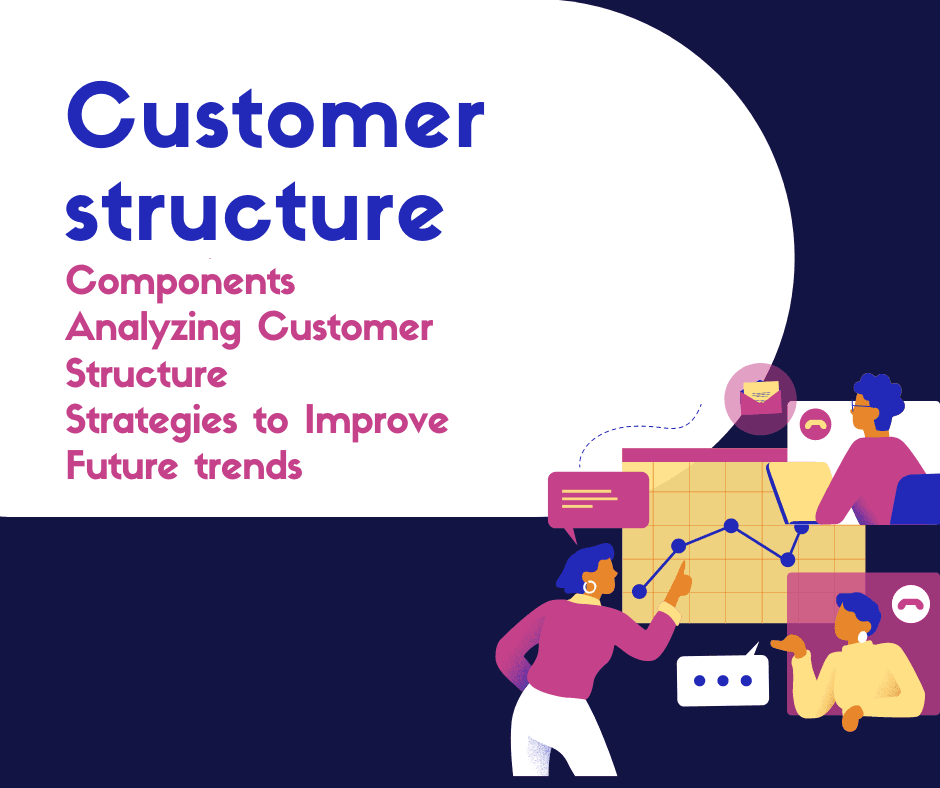The respectable business operations requirement is deep knowledge of the customers, from which market gaps can be identified. Customer structure, a conceptual structure that is so significant and made up of customer classification and understanding, lies at the center of customers’ comprehension, demonstrating an excellent example of consumers’ classification and understanding. This involves gathering data about the customers to identify their purchase patterns, preferences, and buying needs and to perform a segmentation or profiling of the customers either demographically or psychographically. It serves as a business strategy and a virtual compulsion for any business seeking to connect better, engage, and earn the loyalty of its consumer base.
Components of Customer Structure

To understand clients and build products and services on the exact problems of customers, the following components of customer structure must be taken into consideration:
- Demographic Segmentation: Here, it means determining customer segmentation with the help of demographic data of age, sex, geo-location, and income. An example is when a cosmetic company aims to target women aged 20-25 who reside in the town and have the expected income level.
- Psychographic Segmentation: This involves the conversation on what your personality traits are, what lifestyle you lead, what interests you have, and how you see your life. Likewise, a travel agency can create trips that align with the interests of adventurists and high-incoming people. On the other hand, the company can include families interested in budget journeys in its program.
- Behavioral Segmentation: This suggests customers undertaking their organizational behaviors based on how they purchase it, which indicates the variety of products they buy, the amount, the purchasing period, and their preferences. It highlights the items customers are willing to buy, their top coffee mix selections, the time they visit local coffee shops, and their loyalty level.
- Customer Profiles: Businesses may collect data that will enable them to figure out the market more adroitly and, thus, craft better customer profiles or personas. This is the embodiment of how a customer would often feel while communicating, and this is the pointer that businesses can understand their traits and weaknesses. Thus, a company could design a character like “Tech-Savvy Tim,” who pursues the latest trends in the electronics realm but does not mind spending money to get the best product.
- Customer Journey Mapping: This explains the steps customers go through before they buy a product or use a service to their warranty or any extra after-sales service. Customer journey mapping is essential for identifying things that irritate customers before they become problematic, like improving their conversion rate or increasing customer support. For instance, an online shopping site can build a smooth checkout process to avoid visitors dropping the abandoned cart.
Analyzing Customer Structure
Analyzing the customer structure is a multi-angle approach that puts several data channels in the picture, such as CRM, surveys, website analytics, and social media interactions. The principal goal involves the collection of necessary data for decision-making. They are sourced to gather relevant information and provide a detailed understanding of customers.
This provides the insight that the management needs to dominate social media and other online platforms.
Businesses with a good customer structure analysis understand their client base in detail. Thus, they can adjust their business model and approach marketing strategies to fit their customers regularly.
Then, the data will be collected, and the following process will necessitate pinpointing trends and patterns that may eventually be discovered from the analysis. Such analysis embraces the identification of the profitability of products and services, the acquaintance with customer engagement levels, the assessment of retention rates, and the clustering of cross-selling opportunities based on segmentation.
Therefore, the jeans retail store may realize that these customers make double purchases, which includes a belt, indicating the possibility of cross-selling other products that complement well. By identifying these trends, businesses can push marketing efforts to the next level, product offerings, and target marketing campaigns to capture specific market segments.
The idea of analyzing customer structure is to inform businesses of the possible changes they need to make to adapt and tune their strategies to match the unpredictable behavior of customer groups. Implementing this philosophy involves a multifunctional approach focused on personalization, establishing relationships, and continuous development. One of the key tactics is personalization, which requires businesses to provide their customers with personalized interactions.
To illustrate, a merchandiser may utilize customized marketing, which, in turn, branches into different marketing campaigns that suit the customers’ interests and way of life. Moreover, the recommendation of customized products based on clients’ history and past performance allows the customer to feel regarded and, as such, enhances the customer experience.
Strategies for Enhancing Customer Structure
The following are ways to enhance customer structure.
- Rapport-building through CRM Utilization: An option herein will be implementing a CRM system; this plays a role in clients’ information capture, such as their profile, communication history, and favorite merchandise. Provide such services with creative loyalty programs that give them an attachment as regular clients and create a feeling of oneness and normality.
- Continuous Customer Analysis and Adaptation: While the client-based data are more unveiled hourly, consider market demand changes. Innovate your product’s functionality to capture changing customer tastes into your new product—the only product consumers ever need.
- Data-driven Decision-making: Cultivate the utilization of data analysis methods that should be content for the customer and operate as a new B2B asset. For example, customer targeting is made through different advertisements for Coca-Cola products everywhere, suggestions for Netflix content based on your choice, Amazon recommendations based on your purchase history, and the provision of Uber’s services in the most demanded areas.
- Effective Customer Management Systems: Tesco is a good case study, as they use the Clubcard program to develop market-specific policies to meet customer needs. Build programs like points and vouchers featuring as a reward, hence, more customer loyalty and engagement. Share the platform with other organizations so the customers can enjoy more benefits and employ the new tools that will be convenient for our clients’ advertising.
- Addressing Challenges: Analyse challenges posed by privacy inconvenience, auto-machine balancing with human talk in the global digital marketing space, and the need for maintaining consistent dialogues across social media platforms. Provide secure publicization of the data alongside ensuring security compliance with the data. While automation and personalization are aimed to be balanced, customers move through different journey channels.
- Demographic Analysis and Feedback Utilization: Find out the customers’ themes, likes, and dislikes by analyzing answers to questionnaires and studies. As social networking triggers personalization and connection, it pushes social marketing to promote the personalization of consumers’ experiences.
Although the techniques add structure to customer service, they help employees deliver absolute customer satisfaction and loyalty and run a sustainable venture in the market.
Future Trends in Customer Structure
What’s in store for the future of customer structure is the implementation of AI and machine learning, enabling businesses to optimize their data for predicting customer behavior and ensuring higher levels of personalization in large-scale experiences. Predictive analytics is another area of marketing applications that allows companies to forecast clients’ needs and make activities ahead of expectations. Integration based on omnichannel is meant to ensure that consumers have a smooth user experience from stores to online shopping.
Conclusion
Finally, the customer structure in which a firm is managed holds significant weight in the sustainability of business operations. By personalizing, optimizing, and making data-driven business insights, companies can do more than only meet but exceed customer expectations. They generate growth and profitability as a result of this.
